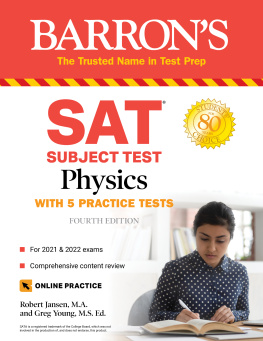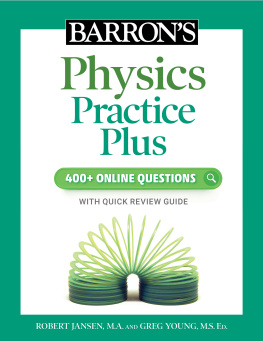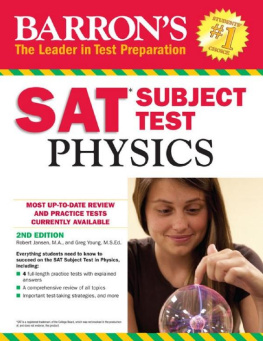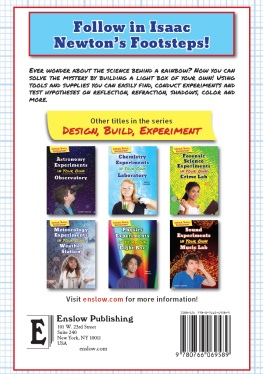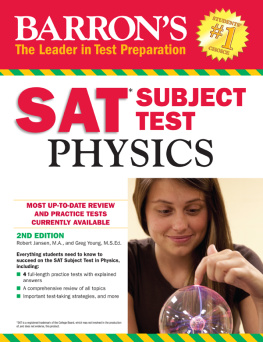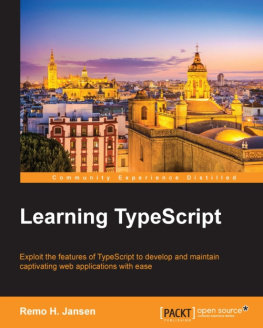Robert Jansen - SAT Subject Test Physics
Here you can read online Robert Jansen - SAT Subject Test Physics full text of the book (entire story) in english for free. Download pdf and epub, get meaning, cover and reviews about this ebook. year: 2020, publisher: Barrons Educational Series, genre: Children. Description of the work, (preface) as well as reviews are available. Best literature library LitArk.com created for fans of good reading and offers a wide selection of genres:
Romance novel
Science fiction
Adventure
Detective
Science
History
Home and family
Prose
Art
Politics
Computer
Non-fiction
Religion
Business
Children
Humor
Choose a favorite category and find really read worthwhile books. Enjoy immersion in the world of imagination, feel the emotions of the characters or learn something new for yourself, make an fascinating discovery.
- Book:SAT Subject Test Physics
- Author:
- Publisher:Barrons Educational Series
- Genre:
- Year:2020
- Rating:5 / 5
- Favourites:Add to favourites
- Your mark:
- 100
- 1
- 2
- 3
- 4
- 5
SAT Subject Test Physics: summary, description and annotation
We offer to read an annotation, description, summary or preface (depends on what the author of the book "SAT Subject Test Physics" wrote himself). If you haven't found the necessary information about the book — write in the comments, we will try to find it.
SAT Subject Test Physics — read online for free the complete book (whole text) full work
Below is the text of the book, divided by pages. System saving the place of the last page read, allows you to conveniently read the book "SAT Subject Test Physics" online for free, without having to search again every time where you left off. Put a bookmark, and you can go to the page where you finished reading at any time.
Font size:
Interval:
Bookmark:

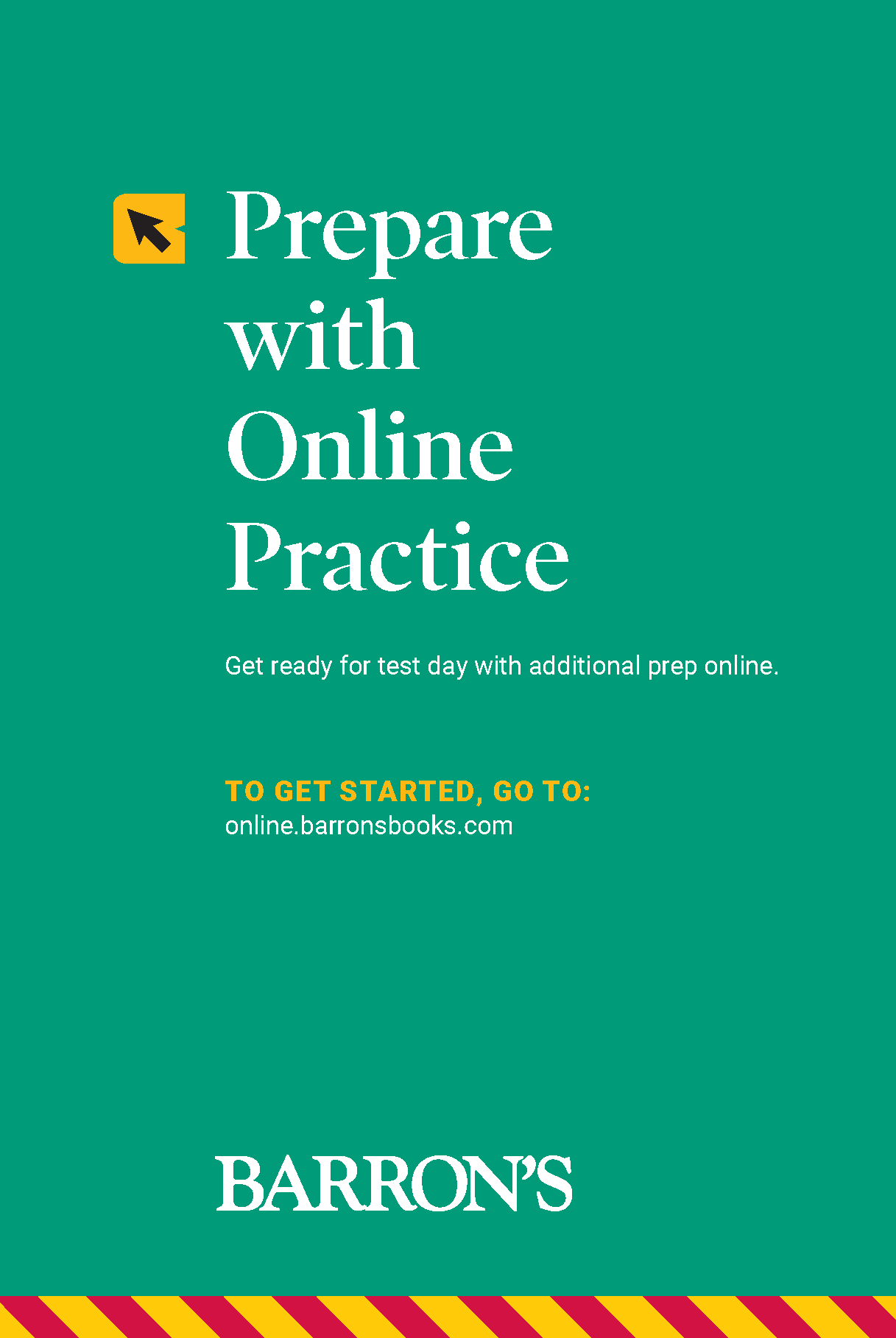
About the Authors
Robert Jansen has taught Advanced Placement Physics at Aliso Niguel High School in Aliso Viejo, California, since 1998. He holds a bachelors degree in psychobiology from the University of California, Los Angeles, and a masters degree in education from Pepperdine University. He gravitated toward teaching physics because of the challenging material and a sustained belief that physics does not need to be mysterious and difficult, but rather can be comprehensible and achievable. The result has been a large and competitive physics program where each year over 220 students participate in the AP Physics 1 and AP Physics C courses. The overarching goal is preparedness and confidence for students who will be studying science during their undergraduate years.
Greg Young has been teaching high school science for more than twenty years. He currently teaches Honors Physics, AP Chemistry, and Chemistry at San Clemente High School in San Clemente, California. He holds a bachelors degree in biochemistry from the University of California, San Diego and a masters degree in science education from USC. Having always been interested in science and how to make it relevant to others, Gregs interest in teaching lies in being able to create interactive lessons that engage students in their learning and form a relevant context for difficult concepts in physics and chemistry. Science made interesting is science worth learning.
Copyright 2020, 2019, 2016, 2013 by Kaplan, Inc., d/b/a Barrons Educational Series
All rights reserved under International and Pan-American Copyright Conventions. By payment of the required fees, you have been granted the non-exclusive, non-transferable right to access and read the text of this eBook on screen. No part of this text may be reproduced, transmitted, downloaded, decompiled, reverse engineered, or stored in or introduced into any information storage and retrieval system, in any form or by any means, whether electronic or mechanical, now known or hereinafter invented, without the express written permission of the publisher.
Published by Kaplan, Inc., d/b/a Barrons Educational Series
750 Third Avenue
New York, NY 10017
www.barronseduc.com
ISBN: 978-1-5062-6709-8
10 9 8 7 6 5 4 3 2 1
Kaplan, Inc., d/b/a Barrons Educational Series print books are available at special quantity discounts to use for sales promotions, employee premiums, or educational purposes. For more information or to purchase books, please call the Simon & Schuster special sales department at 866-506-1949.
The SAT Subject Test in Physics is designed to assess the outcome of completing a college-preparatory physics course in high school. Although state and course requirements for physics may vary, all college-preparatory physics courses should address certain core topics and principles. The SAT Subject Test in Physics focuses on this common ground. The goal of this book is to review the main topics and concepts that are likely to appear on the SAT Subject Test in Physics and help you prepare for the exam.
The chapters are organized to maximize the effectiveness of your study time. Each chapter begins with a summary of the topics to be covered, bulleted points of the major topics, and a list of new variables discussed in the chapter. The body of the chapter includes a discussion of the topics along with relevant example questions. Each chapter also includes a unique Whats the Trick? approach to help you solve the questions quickly and effectively. The margins contain tips called If You See... that point out some of the major insights into critical topics and difficult concepts. The end of the chapter contains a bulleted summary along with a table grouping the critical If You See... elements as a concentrated review. Each chapter is followed by multiple-choice practice questions with answers and explanations.
To see the Table of Contents for Video Problems, go to online.barronsbooks.com
In addition to the chapters that review the exam content, the book includes four complete practice exams. The first practice exam is a diagnostic test to assess your current level of understanding of the subject matter and to establish a baseline score to improve upon. Ideally, you should take this first diagnostic examination using the same guidelines as an actual SAT Subject Test in Physics:
- Time limit of 1 hour for 75 multiple-choice questions.
- NO calculators allowed.
- No physics formula sheet is allowed, and none will be provided.
- Correct answers receive 1 point.
- Subtract point for each incorrect answer.
- Answers left blank receive 0 points.
A complete list of test-taking parameters and how to find your approximate raw score is provided near the end of this introduction. You should take the other three examinations after you have completed all or portions of your review.
Different students will approach this review in a variety of ways. Some may choose to work methodically through each chapter, which will require starting well before the actual exam date and setting aside adequate review time. Students with limited time may decide to read the important If You See... tips in the margins and attempt the end-of-chapter questions to determine if they should study a particular chapter in depth. Keep in mind that each chapter builds on the material from previous chapters. Skimming the material too quickly, especially in chapters containing key foundational material, can result in errors throughout the entire exam. Remember these helpful tips as you use this review book:
- Start reviewing the material well before the exam date. Set aside an hour or two each day to read through the chapters. Trying to cram in all the information at once is not as effective as reviewing smaller portions over time.
- Solve the practice problems as though they are an actual exam. Merely reading the solutions without actually attempting to solve the problems will not help you to understand the material.
- Being able to visualize the events described in an exam question is a valuable skill in physics. Students who construct diagrams to represent the situations described in physics problems tend to earn better scores on the exam.
- Some questions require you to recall facts, and others require you to understand concepts and principles. Many involve the use or understanding of formulas without complicated arithmetical calculations. Calculators are not allowed on the examination, and a list of formulas is not provided. Therefore, memorizing key physics formulas and having a working knowledge of how to manipulate variables are crucial for success.
A complete outline of the contents of the SAT Subject Test in Physics can be obtained from the College Boards website at http://sat.collegeboard.org. The College Board, which writes and administers the examination, does not publish copies of former examinations. However, they do offer sample questions on their website.
All questions are multiple choice and have five answer choices. The practice tests and sample questions in this book reflect both the content and the question formats found on the SAT Subject Test in Physics. The exam tests students knowledge in six topics.
The content and approximate percentage of the test devoted to that content is as follows:
Font size:
Interval:
Bookmark:
Similar books «SAT Subject Test Physics»
Look at similar books to SAT Subject Test Physics. We have selected literature similar in name and meaning in the hope of providing readers with more options to find new, interesting, not yet read works.
Discussion, reviews of the book SAT Subject Test Physics and just readers' own opinions. Leave your comments, write what you think about the work, its meaning or the main characters. Specify what exactly you liked and what you didn't like, and why you think so.

